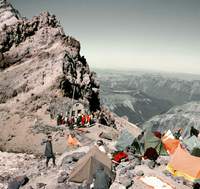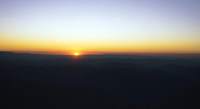Rainier: Emmons Glacier
First time up Rainier: pretty dull.
Included for background.
Counting my first ascent of Mount Rainier up the
Emmons Glacier
with the UW climbing course,
I was 6 for 6 for Spring and Summer ascents of the mountain.
Since the success rate on Rainier is about 50%,
this is a remarkable record,
even though I have to admit that this was in large part due to having
very good conditions for the climbs rather than an excess of skill.
We carried full packs to the summit 4 times and descended by a different
route
(Emmons or Ingraham)
4 times;
I was leader on 3 of the climbs.
I tell people I climbed Rainier 6 times by 7 routes
(having never gone up the Ingraham route).
For all of my Rainier ascents,
no fees were involved–not even fees to enter the park.
Now,
one must pay a
pay a fee
of $44 or $31
(depending on age)
to climb the mountain.
And now,
rangers are not likely to check your qualifications and equipment.
For my climb of the
Kautz Glacier
the rangers appeared to be ready to deny permission until they checked
my qualifications.
At that time,
rangers actually inspected your equipment and there were stories of
rangers doing things like laying your ice axe across a rock and jumping
on it if they felt your equipment was inadequate.
The UW climbing courses included a Summer 'Seminar' of what were
essentially guided climbs for persons who had completed the Basic
Climbing Course.
The instructor I had for the Basic Climbing Course was the lead that year.
After the Summer seminar,
he asked Dave Christensen and I to be assistant instructors for a number
of subsequent sessions of the Basic Climbing Course.
One of the climbs for the Summer session was Mount Rainier via the
Emmons Glacier.
This is one of the two easiest routes on the mountain,
but it can
be deadly
when things go wrong and bad weather can delay
recovery efforts.
The other
“easy”
route is the Ingraham Glacier;
however,
there tends to be a lot more traffic on the Ingraham route–
so much that there is usually a trough in the snow all the way.
There is less traffic on the Emmons Glacier so there were
few parties on the route other than our party of 15-20 persons.
Our climb began at the White River Campground with an equipment check to
make sure we all had the proper equipment to make the climb.
From the campground,
we trekked up the trail to the Inter Glacier,
where we roped up and continued our ascent to a base camp at Camp
Schurman.

The plaque on the ranger's hut at Camp Schurman contains a little poem
by one of the early guides at Mount Rainier.
It reads:
"Into a cloud sea far below,
I lonely watched the red sun go.
Then turning,
miracle of glad surprise,
enchanted saw the full moon rise."
— C. Y. Schurman

The quoted poem suggests one of the great treats of climbing Rainier:
an unobstructed view of clouds,
sunrise,
sunset,
stars,
moon rise,
moon set and lights of the cities below while at high camp and during the
pre-sunrise hours of the ascent.
The following morning,
at the appointed departure time of 1:00am,
a number of people decided to stay at the Camp Schurman high camp rather
than climb;
perhaps the climb from 4,400 feet at the White River campground to the
9,700 foot elevation of Camp Schurman convinced them they did not want to
undertake the 4,700 foot climb to the summit followed by a 10,000 foot
descent to the cars.
I recall one of the party was a former math professor of mine;
he spent the night chatting with his tent mate about mathematics until
someone suggested that others would like to get some sleep.
He and his tent mate decided not to make the climb.
We completed it without difficulty or excitement.

At the summit,
we stood at the highest point of the crater rim and looked across the
1,000 foot diameter of the crater.
We sheltered below the crater rim from the 70mph winds for a while
before beginning our descent.
Upon return to Camp Schurman,
we packed up our gear and continued to our cars at the White River
Campground and a drive back home to Seattle.
One of the big challenges for people climbing Rainier is the altitude;
most climbers are living at sea level in the Seattle area and the
transition to 14,410 feet
(approximately 10,000 feet of that on foot)
is difficult for all but the most physically fit.
To make this point to our sea level friends,
we would drink one of our water bottles dry,
close it tightly and show it around when we got home.
Since the amount of air per unit volume at the summit is
less than 60% of that at sea level,
the poor bottles were literally crushed.
Need I say that we used flexible plastic bottles for this demonstration?
Some people who carried cheap metal canteens and failed to vent them on
the way down were sad to find them crushed when they unpacked at home.
Other Rainier Climbs


